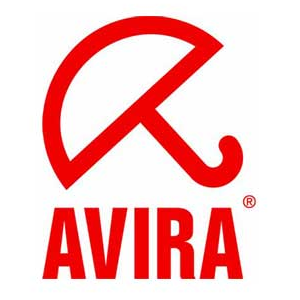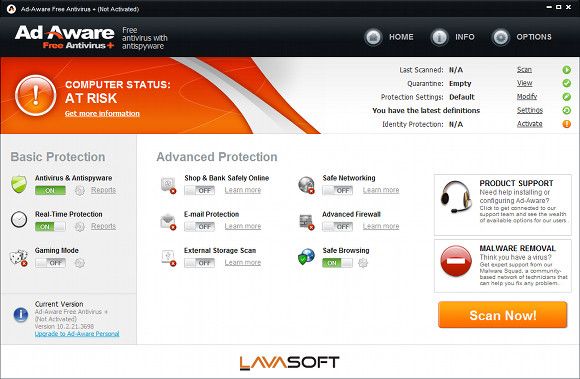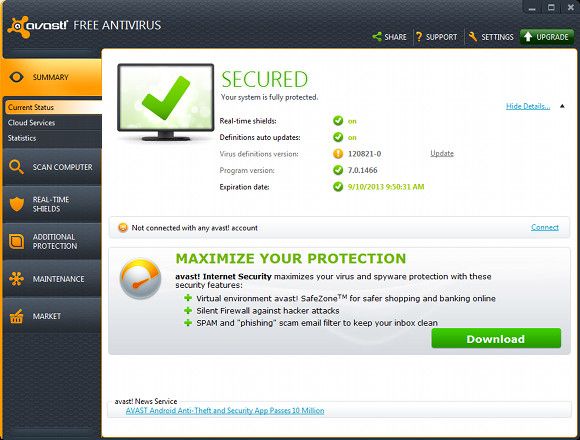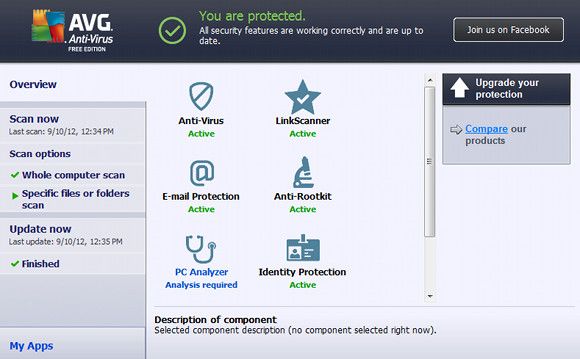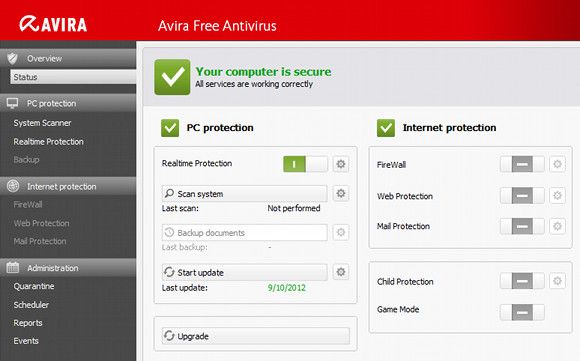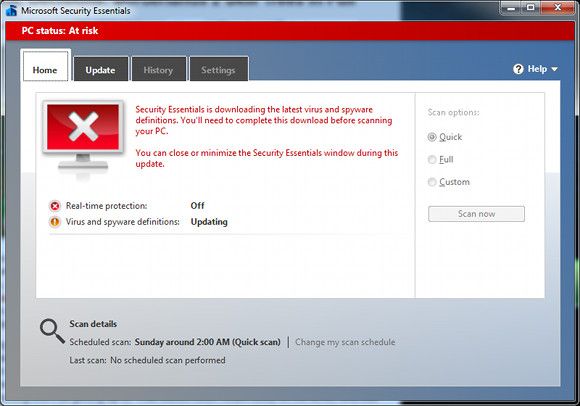What is the best free antivirus? This is among the most common questions we receive at MakeUseOf. People want to be protected, but they don’t want to have to pay a yearly fee or use bloated security suites with unwanted features. I myself am a free antivirus user for these very reasons.
Discovering the best anti-virus isn’t easy, however. There are a lot of points to consider including the user interface, resource and overall effectiveness against the baddies. Let’s take an in-depth look at five popular choices (Avast!, AVG, Ad-Aware, Avira and Microsoft Security Essentials) to see which is best.
Criteria
Our performance testing in this article consisted of a selected scan of a single 500GB mechanical hard drive that was approximately half-full. We used the full scan option. Our gauge of memory usage is based off the memory the software uses while running in the background and is the rounded average of what I witnessed over three minutes of use.
Protection information comes from AV-Comparatives and AV-Test, two leading sources for information about antivirus effectiveness. The specific studies referenced are AV-Comparative’s March 2012 Detection Test and AV-Test’s June 2012 round-up.
All testing was done under Windows 7 64-bit.
Lavasoft Ad-Aware Free Antivirus+
Lavasoft's rather wide main menu does a good job of providing information without overwhelming the user. Most of the features are turned on or off using sliders and the big, bright “Scan Now!” button makes it immediately clear where a user needs to click to perform a scan.
I was somewhat confused by the custom scan options, however, because individuals drives can’t be selected before a specific box in the options is checked.
Lavasoft tries to lure users in by displaying advanced features that can’t be used until the full version is activated. It’s a bit disappointing to find a feature is not available, but this approach is less bothersome than the sidebar ads used by AVG.
Performance didn’t prove to be a strong point. A full scan took a tad over twenty minutes, the second-longest result. The background application consumed about 32 megabytes of RAM while idle. That’s not enough to drag down most systems but it is by far the worst result among the software evaluated here.
AV-Comparatives still does not include Lavasoft products in its file detection tests. AV-Test does test it, however, and found that it was able to handle 99% of recently discovered threats during the most recent round-up. The only flaw is 0-day attacks. Lavasoft detected just 80% of those threats, which ties Microsoft Security Essentials for last place.
Avast!
Avast! features an interface that appears smooth and modern relative to most competitors. Its large window includes a lot of free white space and provides all the information you need to know about your computer’s current protection.
I really like the software’s real-time shield menu. It lumps all of the different threat vectors which Avast! protects against into one menu and shows you how much of each have been scanned. It even updates in real-time as new potential threats are checked.
Advertising is included but is mostly restricted to the installation process and the main menu. The computer scan and real-time shield menus, which users will deal with most frequently, are devoid of ads.
A full scan of our test drive required about 15 minutes, the second-best result. The background process required 3.5 megabytes of RAM at idle, which is technically the middle result.
Avast! missed about 2% of all samples thrown at it in the last AV-Comparatives malware detection test, an average result. The last AV-Test comparison agreed with those findings.
AVG
The interface of AVG is simple. It provides a list of icons, each representing a form of protection, and places the scan functions to the sidebar. The “Scan Now” link is literal. Click on it, and AVG will starts to work on your entire computer without any additional prompts.
While the basic anti-virus features are easy to use the additional components are a bit bewildering. AVG includes everything from e-mail protection to rootkit protection. A lot of these components are handicapped, however, and direct you to buy one of AVG’s paid solutions. Other icons direct users to AVG products on other platforms, like Android.
AVG posted the least impressive scan time result. It required almost 23 minutes to chew through our 500GB test drive – about 75% longer than the quickest competitor. The background process, however, was the second smallest. It consumed just 2.4 megabytes of RAM at idle.
AV-Comparative’s last file detection test found that AVG missed about 3.5% of all threats thrown at it, one of the least impressive scores in the test group. AV-Test, however, found that the software detected 99% or recent threats in its last round-up.
Avira
Avira has a confusing interface. For example, performing a specific scan requires that the user go to the System Scanner menu, then click on an option, then click a very small magnifying glass icon. Alternatively you can click the gear button on the main menu, but this opens up another menu that declares you must be in "expert mode" to change settings. Uh, what is expert mode? The big fat “Scan!” button used by competitors is more intuitive.
In-app advertising was light, but I was hit by a pop-up advertisement immediately after installing the software. Pop-up ads on my desktop are extremely annoying and not something I want to see, ever. There are also many features which are visible, but disabled until you buy the full version.
Avira blew away the competition in our performance tests. It required just over 13 minutes to perform a full hard drive scan and its background process consumed a measly 1.8 megabytes of RAM at idle. This software is clearly the best for users who prefer protection that is light on system resources.
Avira did extremely well in the last AV-Comparatives file detection test. It missed less than .5% of all samples and scored second-best overall, beating all other free solutions tested. Avira also detected 99% of recently discovered threats in the last AV-Test roundup.
Microsoft Security Essentials
Microsoft Security Essentials is different from the competitors because it’s not a marketing tool. All the other vendors offer their free anti-virus in an attempt to earn name recognition and impress users, but Microsoft has no paid anti-virus to sell. This makes for a clean interface that’s not cluttered by advertisements.
Some of the cleanliness is due to a lack of features, however. MSE can scan for, detect, quarantine and attempt to remove a virus, but that’s all it does. There’s no mobile version, no e-mail protection, no bundled anti-phishing. It is, as the name implies, only the “essentials.”
MSE posted middling results in our performance tests. It required almost twenty minutes to fully scan our test drive and its background process consumed about 6.8 megabytes of RAM at idle.
Early testing of MSE suggested it was surprisingly competent, but more recent tests have been less kind. MSE came in last during the most recent AV-Comparatives file detection test. It missed almost 7% of all samples. AV-Test found that it missed 5% of recently detected samples in its last round-up.
So Which Is Best?
Avira is the technical standout. It has posted excellent scores in recent protection tests and it also ran away from the competition in our performance metrics. The downside is a confusing user interface. I had to explore the software for a few minutes before I understood how to operate it. If Avira could make the software just at tad more intuitive it would have the perfect product.
Avast! may be a better option for users who want to fuss with protection as little as possible. It is nearly as good as Avira in our performance benchmarks and it offers a slick, simple interface. Advertising is kept to a minimum, as well.
Lavasoft and AVG are suitable choices, but both have a catch that may be significant for some users. Lavasoft uses far more resources than the competitors while running in the background and AVG has an unattractive interface loaded with advertisements for the full version and other AVG products. Both offer competent protection, however.
Last, and least, is Microsoft Security Essentials. It was not the slowest in our tests, nor did it eat the most RAM, but protection studies have shown it to be the least effective at stopping threats by a large margin. Missing 5% of recent threats in the AV-Test roundup doesn’t sound like much, but all other competitors missed 2% or less. Going with MSE makes you substantially more vulnerable.

